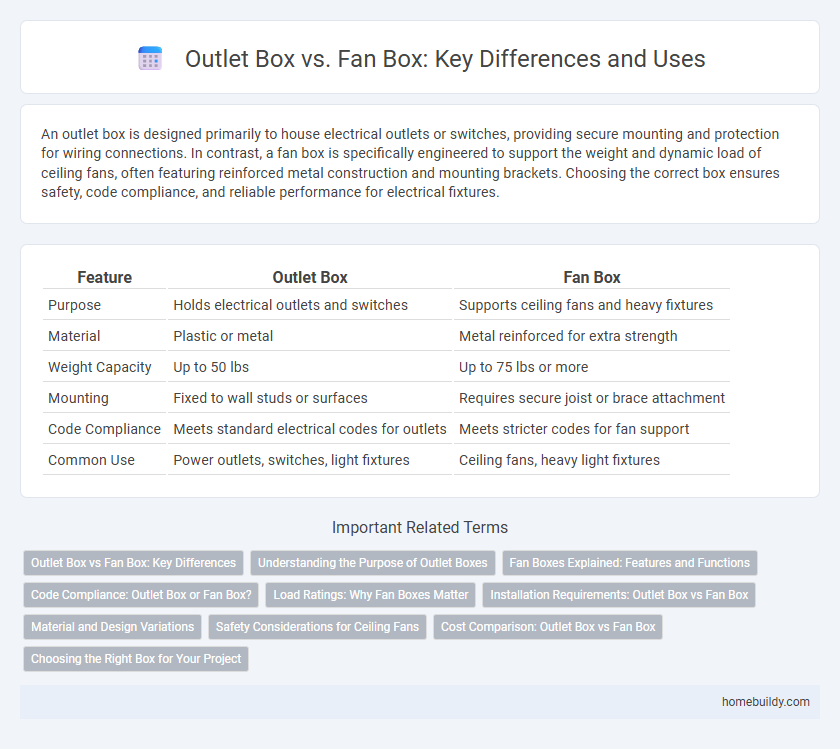An outlet box is designed primarily to house electrical outlets or switches, providing secure mounting and protection for wiring connections. In contrast, a fan box is specifically engineered to support the weight and dynamic load of ceiling fans, often featuring reinforced metal construction and mounting brackets. Choosing the correct box ensures safety, code compliance, and reliable performance for electrical fixtures.
Table of Comparison
| Feature | Outlet Box | Fan Box |
|---|---|---|
| Purpose | Holds electrical outlets and switches | Supports ceiling fans and heavy fixtures |
| Material | Plastic or metal | Metal reinforced for extra strength |
| Weight Capacity | Up to 50 lbs | Up to 75 lbs or more |
| Mounting | Fixed to wall studs or surfaces | Requires secure joist or brace attachment |
| Code Compliance | Meets standard electrical codes for outlets | Meets stricter codes for fan support |
| Common Use | Power outlets, switches, light fixtures | Ceiling fans, heavy light fixtures |
Outlet Box vs Fan Box: Key Differences
Outlet boxes are designed primarily to house electrical outlets and light switches, supporting wiring and devices without the need for heavy structural support. Fan boxes, however, are built to support the weight and movement of ceiling fans, featuring stronger materials and secure mounting brackets to handle dynamic loads. The key differences lie in load capacity, installation requirements, and structural reinforcement to accommodate either standard electrical devices or heavier ceiling fans.
Understanding the Purpose of Outlet Boxes
Outlet boxes are primarily designed to house electrical connections for switches and receptacles, providing a secure enclosure that prevents electrical hazards. Fan boxes, a subset of outlet boxes, are engineered with reinforced structures to support the additional weight and vibration of ceiling fans. Understanding the purpose of outlet boxes helps ensure proper installation and safety compliance in both lighting and fan applications.
Fan Boxes Explained: Features and Functions
Fan boxes are specifically designed to support the weight and dynamic load of ceiling fans, featuring reinforced metal or heavy-duty plastic construction for enhanced durability. Unlike standard outlet boxes, fan boxes include pre-installed brace bars or mounting brackets to ensure secure attachment to ceiling joists, preventing wobbling and ensuring safety during operation. Their functionality extends to accommodating electrical wiring for both the fan motor and integrated lighting, making them essential components in fan installations.
Code Compliance: Outlet Box or Fan Box?
An outlet box and a fan box serve different purposes in electrical installations, with fan boxes specifically designed to support the additional weight and vibration of ceiling fans, meeting NEC code requirements. Outlet boxes typically must be rated for fan installation if used for ceiling fans, ensuring secure mounting and preventing electrical hazards. Code compliance mandates using UL-listed fan boxes for ceiling fan installations to avoid violations and enhance safety.
Load Ratings: Why Fan Boxes Matter
Outlet boxes typically support standard electrical devices with load ratings around 50 lbs, while fan boxes are engineered to accommodate heavier ceiling fans and fixtures, often rated for 70 lbs or more. Fan boxes feature reinforced metal or plastic structures designed to safely bear dynamic loads and vibration caused by fan operation. Choosing the correct fan box ensures compliance with electrical codes and prevents structural damage or electrical hazards caused by inadequate load support.
Installation Requirements: Outlet Box vs Fan Box
Outlet boxes are designed to support standard electrical devices such as switches and receptacles, requiring minimal support and typically installed directly into wall studs or ceiling joists. Fan boxes must meet stricter installation requirements, including reinforced support to handle the weight and dynamic load of ceiling fans, often incorporating metal bracing or fan-rated boxes to ensure safety and stability. Proper adherence to local electrical codes and manufacturer guidelines is essential during installation to prevent hazards and ensure functional performance.
Material and Design Variations
Outlet boxes are typically constructed from plastic or metal, designed to securely house electrical outlets and switches, while fan boxes are usually metal and built to support the heavier weight and vibration of ceiling fans. Fan boxes often feature reinforced mounting brackets and increased depth to accommodate fan mounting hardware. Material strength and box design are crucial for safety and functionality when comparing outlet boxes to fan boxes.
Safety Considerations for Ceiling Fans
Outlet boxes are typically designed to support only standard electrical fixtures and may not bear the weight or motion of a ceiling fan safely. Fan boxes are specifically engineered with reinforced materials and secure mounting brackets to handle the dynamic loads and vibrations caused by ceiling fans. Using a proper fan box ensures compliance with electrical codes and reduces risks of structural damage or electrical hazards.
Cost Comparison: Outlet Box vs Fan Box
The cost difference between an outlet box and a fan box primarily stems from their design and load capacity requirements, with outlet boxes typically costing less due to simpler construction. Fan boxes are engineered to support heavier loads, such as ceiling fans or light fixtures, which increases their material strength and installation complexity, resulting in higher prices. Homeowners should consider these cost variations alongside safety and functionality needs when selecting between outlet and fan boxes.
Choosing the Right Box for Your Project
Selecting the right outlet box ensures proper support and safety for electrical connections, especially when distinguishing between standard outlet boxes and fan boxes. Fan boxes are specifically designed to support the heavier weight and dynamic load of ceiling fans, often including reinforced metal brackets or straps for secure mounting. Choosing an appropriate box based on load requirements and installation location prevents structural damage and ensures compliance with electrical codes.
Outlet box vs Fan box Infographic

 homebuildy.com
homebuildy.com